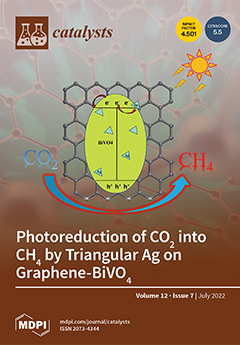Excessive concentrations of nitrate (NO
3-N) in water lead to the deterioration of water quality, reducing biodiversity and destroying ecosystems. Therefore, the present study investigated NO
3-N removal from simulated wastewater by nanoscale zero-valent iron-supported ordered mesoporous Zr-Ce-SBA-15 composites (nZVI/Zr-Ce-SBA-15) assisted
[...] Read more.
Excessive concentrations of nitrate (NO
3-N) in water lead to the deterioration of water quality, reducing biodiversity and destroying ecosystems. Therefore, the present study investigated NO
3-N removal from simulated wastewater by nanoscale zero-valent iron-supported ordered mesoporous Zr-Ce-SBA-15 composites (nZVI/Zr-Ce-SBA-15) assisted by response surface methodology (RSM), an artificial neural network combined with a genetic algorithm (ANN-GA) and a radial basis neural network (RBF). The successful support of nZVI on Zr-Ce-SBA-15 was confirmed using XRD, FTIR, TEM, SEM–EDS, N
2 adsorption and XPS, which indicated ordered mesoporous materials. The results showed that ANN-GA was better than the RSM for optimizing the conditions of NO
3-N removal and the RBF neural network further confirmed the reliability of the ANN-GA model. The removal rate of NO
3-N by the composites reached 95.71% under the optimized experimental conditions (initial pH of 4.89, contact time = of 62.27 min, initial NO
3-N concentration of 74.84 mg/L and temperature of 24.77 °C). The process of NO
3-N adsorption onto Zr-Ce-SBA-15 composites was followed by the Langmuir model (maximum adsorption capacity of 45.24 mg/g), pseudo-second-order kinetics, and was spontaneous, endothermic and entropy driven. The yield of N
2 can be improved after nZVI was supported on Zr-Ce-SBA-15, and the composites exhibited a strong renewability in the short term within three cycles. The resolution of Fe
2+ experiments confirmed that nZVI/Zr-Ce-SBA-15 was simultaneously undergoing adsorption and catalysis in the process of NO
3-N removal. Our study suggests that the ordered mesoporous nZVI/Zr-Ce-SBA-15 composites are a promising material for simultaneously performing NO
3-N removal and improving the selectivity of N
2, which provides a theoretical reference for NO
3-N remediation from wastewater.
Full article





